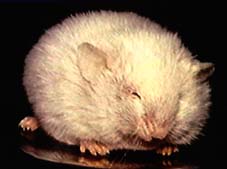HOME > mice > ICGN mice
Strain Detail: ICGN mice
| Strain information | |
|---|---|
| Resource No. | nbio004 |
| Strain name | ICGN |
| Strain Nomenclature | |
| Common name/Synonyms | ICR-derived glomerulonephritis mice |
| Strain types | inbred |
| Background strain | |
| Institution | National Institutes of Biomedical Innovation, Health and Nutrition (NIBIOHN)(formerly, National Institute of Health) |
| Developer | Atsuo Ogura |
| Depositor | |
| Conditions of distribution | without conditions: contact us |
| Animal Health Report | |
| Strain description |  ICR-derived glomerulonephritis (ICGN) mice, a novel inbred strain of mice with a hereditary nephrotic syndrome, were established in the National Institute of Infectious Diseases (NIID, Tokyo, Japan) and considered a good model of human idiopathic nephrotic syndrome. Recently, we found that the tensin2 gene of the ICGN mouse possessed an 8-nucleotide deletion mutation in exon 18, leading to a frameshift and giving rise to a terminal codon at a premature position (Ref.1). The ICGN mice develop proteinuria, hypoproteinemia and hyperlipidemia, enemia and severe systemic edema. Conventional histological analyses demonstrated thickened glomerular basement membranes, loss of podocyte foot processes, enlargement of the mesangial area accompanied by cellular proliferation, enlargement of tubules, and tubulointerstitial lesions. This strain would make a contribution to clarify the mechanisms of idiopathic nephrotic syndrome and develop new therapies for nephrotic syndrome (Ref, 2-6). |
| Reference(s) |
|
| Resource information | |||
|---|---|---|---|
| Cryopreserved sperm | In-house | Genotype | |
| Medium | FERTIUP | ||
| From other institutions | Genotype | ||
| Medium | |||
| Cryopreserved embryo | In-house | Mating System | |
| Genotype | |||
| Medium | EFS40 | ||
| From other institutions | Mating System | ||
| Genotype | |||
| Method | |||
| Strain status / Availability | Cryopreserved sperm | Within 1 month | |
| Cryopreserved embryo | Within 1 month | ||
| Live animals | Approx. 2 months | ||
| Gene information | |
|---|---|
| Mutation types | spontaneous mutation |
| Gene symbol | Tenc1 (Tensin 2) |
| Gene name | Tensin like C1 domain containing phosphatase |
| Genotyping information | |
